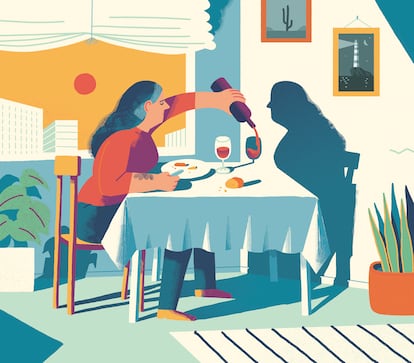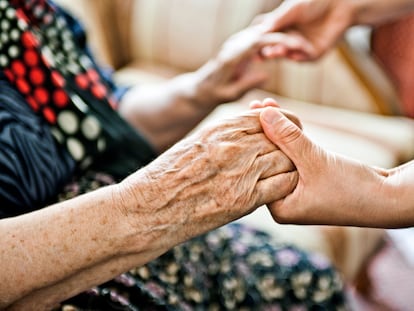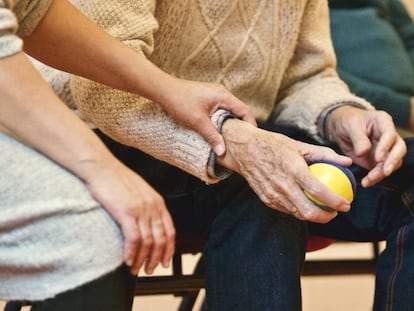How to prevent midlife loneliness from getting you down
Between your 40s and 60s, loneliness can appear amid a sense of general dissatisfaction with life. Understanding it, and combating it, go hand in hand

Middle age — the life period between one’s 40s and 60s, approximately — is an important phase full of continuous adaption to changes that one may or may not have chosen. At this stage, contradictory feelings can emerge: the satisfaction of having completed personal projects, the feeling that certain expectations have not been fulfilled, and the uncertainty of a future still under development. It is considered the least satisfying period of life, because, as Ignacio Peyró writes in one of his recent columns: “Time gradually resizes happiness until it consists of nothing horrible happening to you.”
This period of life can also be suspectable to loneliness. Experts like Albert Paul Weiss and John Cacioppo define loneliness as a psychological condition characterized by a profound sense of emptiness, uselessness, lack of control and personal threat. The emotional impact of loneliness depends on whether it is a frequent, chronic, or occasional feeling. In Spain, a public research facility has been set up to study loneliness (soledades.es). According to its data, it affects 13.4% of the general population and 12% of the middle-aged. Economist Noreena Hertz points out in The Lonely Century various societal and cultural changes are linked to these statistics: the rise of social media that diminishes our number of face-to-face interactions, the rise of individualism over profound connections with those around us, remote work, changes to the family structure, geographic dispersion, the increase in the number of people who live on their own, lack of commitment to community activities, and the loss of social ritual.
The feeling of loneliness varies due to its subjectivity. It’s easier to talk about multiple lonelinesses than a singular loneliness. There is a certain consensus that there are three types: social, existential, and emotional. Social loneliness refers to people who lack social skills, who have a tendency towards isolation and lack a support network. It is linked to attachment types and traumas, and influenced by social and economic inequalities, which in turn are related to social exclusion, according to psychogerontology expert Feliciano Villar.
Existential loneliness is characterized by a disconnection from oneself as well as others. Feelings of isolation, alienation, emptiness, abandonment, and fear are common in this category. Individuals suffer from a what they see as a lack of meaning or purpose in their lives. It is more prevalent among people who have suffered loss, as in a separation or divorce, unemployment and difficulties in accepting it (to which men are especially suspectable), early widowhood, moves, and health problems. Here too are found people who, even if they have not suffered major losses, feel as though their life’s purpose has not been fulfilled in terms of their romantic or familial relationships or career. These individuals make constant comparisons between the life they lead and the life they want.
The final category, emotional loneliness, is experienced by those who are overloaded by responsibility in different areas of their lives. For example, caregivers who suffer from feelings over never getting enough done, a conflict that can rise to the fore when someone’s personal wellbeing comes to depend on the wellbeing of others (children, friends, parents). This causes some people to feel trapped, and is related to the feeling of being alone, despite having others around.
If the feeling of loneliness in middle age becomes chronic, it can lead to missing opportunities in one’s golden years, and even affect one’s health and wellbeing. The Spanish language book La soledad: Comprenderla y gestionarla para no sentirse solo (Loneliness: Understanding it and managing it to not feel so alone), by Girogio Nardone, provides some recommendations. The first is to recognize loneliness and accept it. The second is to understand why one feels this way and to think about the behaviors that perpetuate the problem. The third is to foster moments of connection, bonding, belonging, closeness, and intimacy.
For people who experience severe social loneliness, learning skills or modifying maladaptive cognitive patterns (“no one will talk to me”) may be advisable. For those who suffer existential loneliness, the solution is not only to foster relationships, but to be able to live better with their own loneliness or to empower themselves by embarking on new projects. This means turning loneliness into a more serene experience, as Francesc Torralba points out in the Spanish language El arte de saber estar solo (The art of being on your own). It could also be helpful to offer support and feel useful to those around you. The best way to exist with emotional loneliness involves rethinking projects and familial, laboral and community commitments.
But better managing loneliness doesn’t only depend on the actions of individuals. It involves fostering community bonds, including public and social organizations that can encourage societal change with initiatives towards increasing social connection and fostering feelings of belonging. Loneliness is not a tsunami, nor a disease, but rather something we feel throughout our lives, and is linked to the fact that we are vulnerable beings, as psychologist Javier Yanguas attests. Perhaps the greatest challenge lies in accepting one’s own vulnerability.
Sign up for our weekly newsletter to get more English-language news coverage from EL PAÍS USA Edition
Tu suscripción se está usando en otro dispositivo
¿Quieres añadir otro usuario a tu suscripción?
Si continúas leyendo en este dispositivo, no se podrá leer en el otro.
FlechaTu suscripción se está usando en otro dispositivo y solo puedes acceder a EL PAÍS desde un dispositivo a la vez.
Si quieres compartir tu cuenta, cambia tu suscripción a la modalidad Premium, así podrás añadir otro usuario. Cada uno accederá con su propia cuenta de email, lo que os permitirá personalizar vuestra experiencia en EL PAÍS.
¿Tienes una suscripción de empresa? Accede aquí para contratar más cuentas.
En el caso de no saber quién está usando tu cuenta, te recomendamos cambiar tu contraseña aquí.
Si decides continuar compartiendo tu cuenta, este mensaje se mostrará en tu dispositivo y en el de la otra persona que está usando tu cuenta de forma indefinida, afectando a tu experiencia de lectura. Puedes consultar aquí los términos y condiciones de la suscripción digital.
More information
Últimas noticias
Russell Tovey: ‘I was advised many times not to come out, I don’t think there was many people who’d done that — and I feel really proud that I’m one of those that did’
Patagonia’s puma population soars thanks to unexpected prey: penguins
Merz tries to replace Macron at the helm of Europe
Indulgence, punishment and family dynamics: Maintaining a healthy relationship with food during the holiday season
Most viewed
- Christian Louboutin: ‘Young people don’t want to be like their parents. And if their parents wear sneakers, they’re going to look for something else’
- The low-cost creative revolution: How technology is making art accessible to everyone
- US sanctions against jailed cartel leader ‘El Marro’ highlight Mexico’s lack of control over its prisons
- Liset Menéndez de la Prida, neuroscientist: ‘It’s not normal to constantly seek pleasure; it’s important to be bored, to be calm’
- Cartels in Mexico take a leap forward with narco-drones: ‘It is criminal groups that are leading the innovation race’










































